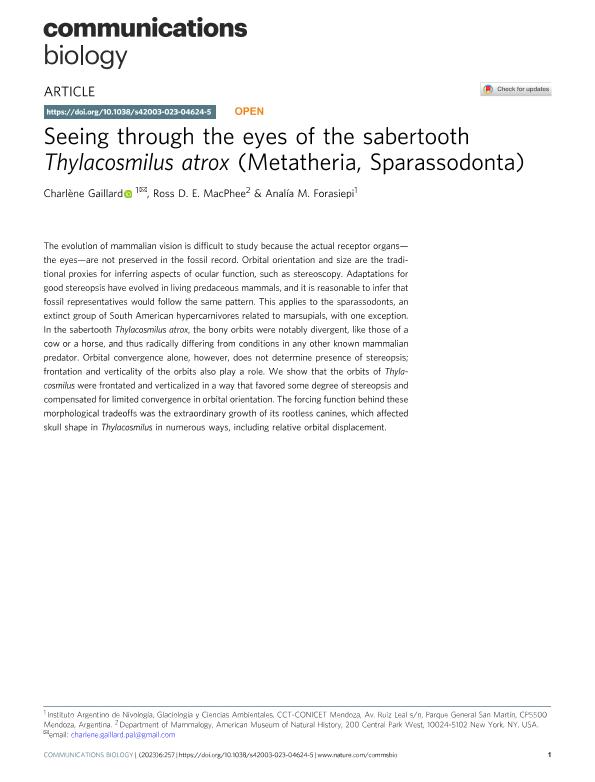Artículo
Seeing through the eyes of the sabertooth Thylacosmilus atrox (Metatheria, Sparassodonta)
Fecha de publicación:
03/2023
Editorial:
Nature
Revista:
Communications Biology
ISSN:
2399-3642
Idioma:
Inglés
Tipo de recurso:
Artículo publicado
Clasificación temática:
Resumen
The evolution of mammalian vision is difficult to study because the actual receptor organs—the eyes—are not preserved in the fossil record. Orbital orientation and size are the traditional proxies for inferring aspects of ocular function, such as stereoscopy. Adaptations for good stereopsis have evolved in living predaceous mammals, and it is reasonable to infer that fossil representatives would follow the same pattern. This applies to the sparassodonts, an extinct group of South American hypercarnivores related to marsupials, with one exception. In the sabertooth Thylacosmilus atrox, the bony orbits were notably divergent, like those of a cow or a horse, and thus radically differing from conditions in any other known mammalian predator. Orbital convergence alone, however, does not determine presence of stereopsis; frontation and verticality of the orbits also play a role. We show that the orbits of Thylacosmilus were frontated and verticalized in a way that favored some degree of stereopsis and compensated for limited convergence in orbital orientation. The forcing function behind these morphological tradeoffs was the extraordinary growth of its rootless canines, which affected skull shape in Thylacosmilus in numerous ways, including relative orbital displacement.
Palabras clave:
Stereoscopy
,
Sparassodonta
,
Vision
,
Predation
Archivos asociados
Licencia
Identificadores
Colecciones
Articulos(IANIGLA)
Articulos de INST. ARG. DE NIVOLOGIA, GLACIOLOGIA Y CS. AMBIENT
Articulos de INST. ARG. DE NIVOLOGIA, GLACIOLOGIA Y CS. AMBIENT
Citación
Gaillard, Charlene; MacPhee, Ross D. E.; Forasiepi, Analia Marta; Seeing through the eyes of the sabertooth Thylacosmilus atrox (Metatheria, Sparassodonta); Nature; Communications Biology; 6; 1; 3-2023; 1-7
Compartir
Altmétricas




